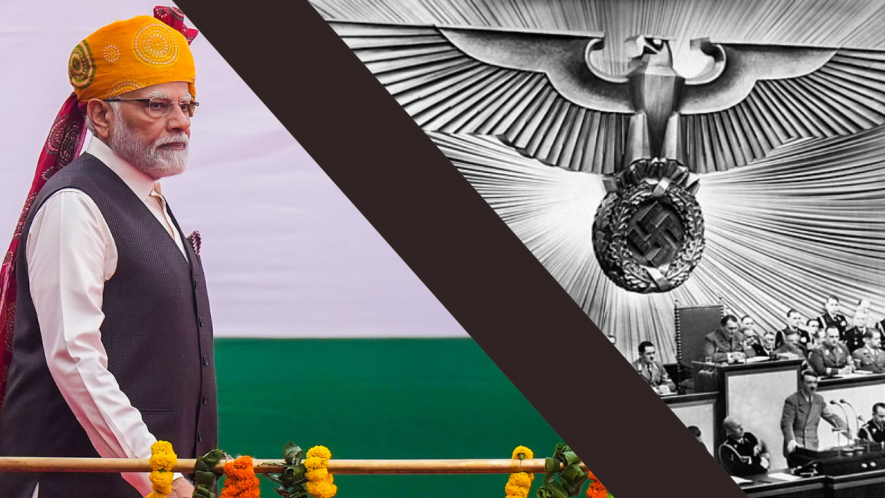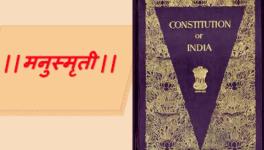Is Modi's 1000 Years of Continuity Promise Similar to Hitler's Proclamation?

Modi has virtually taken the copyright of the phrase -- "1200 saal ki Ghulami" (or 1200 years of slavery) and used it ad nauseam in political rallies.
Ten years ago, almost to the date, a senior investment banker asked at the end of my presentation, "That was comprehensive. But I have a question. What is – to use a term from our youth – (Narendra) Modi's trip, in life?"
The backstory was that my biography of the man, who was not yet the Bharatiya Janata Party's prime ministerial candidate, was just out. Already, people connected with India's financial sector sensed his political arrival and sought a private chat to understand more about the man and his politics.
The answer came out straight from the heart.
"He wishes to become immortal in history," I noticed quizzical expressions at my pause. It made me continue.
"...Modi would like whoever is India's prime minister in 2047 to inaugurate his statue next to Sardar Patel's (construction of the Statue of Unity was about to start), but double its size."
Everyone in the room cracked up at my spontaneous wisecrack.
Several years later, when the Motera Stadium in Ahmedabad was inaugurated by (then) President Ram Nath Kovind after renovation and renaming it as Narendra Modi Stadium, I realised having been only half-correct.
Modi had not waited for three and half decades to be immortalised in concrete and steel. He had permitted this done in his lifetime as if he was not sure if the leaders of the future would pay eulogies to him.
On innumerable occasions in the past nine years, people noted his fascination for the first person singular. There is no doubt anymore that he wishes to not only dominate the present but is working towards securing his place in India's history as the one who shepherded India through the 'transitory' period from an uncertain past to a resurgent future.
In this manner, Modi aims to push other iconic Indian leaders to the background because they were in the past and played 'no part' in putting India on the 'path of glory' and resurrection of its golden past, processes to which Modi is affixing his signature increasingly.
In June, during his state visit to the United States, he told the US Congress that India attained freedom in 1947 "after a thousand years of foreign rule in one form or another."
He blurred the distinction between the colonial period when the British governed India and the assimilative medieval era.
The Sangh Parivar has divided the long period of pre-independence Indian history into the Hindu period, the Muslim period, and then the British period. But Modi fused the last two periods, arguing that the two had a common characteristic – hegemony over Hindus.
For over a decade, Modi has virtually taken the copyright of the phrase -- "1200 saal ki Ghulami" (or 1200 years of slavery) and used it ad nauseam in political rallies.
To dominate contemporary politics, Modi and his Hindu sectarian fellow travellers pooh-pooh India's medieval past, despite the Mughal period being the zenith of the fusion of cultures of the land.
Undeniably, there is stagnation, even retardation, in the present, and this stems from the incapacity of the present regime.
But because Modi will not admit this failure, the strategy is to kickstart a blame game. In ways more than one, accusative politics and whataboutery have been the Sangh Parivar's norm since the 1980s when they launched the Ram Janmabhoomi agitation to cement communal polarisation in the arena of electoral politics.
Every demand – from temples allegedly destroyed to construct Islamic places of worship to controlling Muslim society, their personal laws and everyday behaviour – is justified by pointing to a dead past when Muslims of that time allegedly imposed their writ on Hindus. Muslims of the present are being held guilty for the past despite having little connection.
Modi's speeches at the US Congress and Red Fort were different from his standard political speeches when seeking votes for his party, for he made them as an Indian premier, not as a BJP leader seeking another term in office.
Yet, at both places, he falsified India's history and, instead of dwelling on its complexities, fanned the popular approach of seeing history as just a story of victors and losers, as a story of 'foreigners' establishing their 'rule' over 'our people' or 'us'. This narrative has enabled Modi to evoke anger and hatred at an imagined enemy in the past and those who 'valorise' them in the present time.
The speech on August 15 was noteworthy for a significant alteration in a key postulation, as expounded in his address in June in Washington. In the previous speech, he suggested that the period of slavery ended in 1947. This implicitly bestowed on the national movement leaders (read Congress leaders) the honours for accomplishing this.
But in his latest speech, Modi, in effect, stretched this period of slavery till 2014, which is tantamount to taking credit for ending the era of Indian (read Hindu) subjugation. However, there were parts of the speech that were contradictory to this postulation.
These inconsistencies become discernible on minute scrutiny and reflect Modi's poor capacity for developing hypotheses. But, he gets away with this shortcoming because his primary audience does not comprise people adept at scrutinising postulations. Instead, he reaches out to the masses by use of rhetoric presented in a theatrical manner. This style is common to demagogues in the past, and they continue doing so in today's world.
Modi also presented the medieval era as an extremely exploitative period: "And we kept on getting enslaved, kept on getting caught, kept getting caught; whosoever arrived here, looted us; whoever came, dominated us; what a strange time it must have been, that thousand years."
In the I-Day speech, Modi presented two 1000-year-long epochs, the first of which started "1000-1200 years ago. (when) A small kingdom and its king were defeated. However, we couldn't have known that this event would lead India into a thousand years of subjugation. We got ensnared in slavery..."
Developing the new theme of this epoch of slavery not ending when India became independent, he claimed, "We are at the milestone between 1000 years of slavery and 1000 years of grand future that is about to come. We are at this crossroads, and hence we cannot stop."
Two years ago, Modi created the concept of Amrit Kaal that followed Azadi Ka Amrit Mahotsav – a coinage for the celebrations of the 75th anniversary of independence.
Amrit Kaal is the expression he introduced for the 25-year-long period between 2022 and 2047. In terms of its characteristics, it is considered a period when anything new (idea or project) started or launched is bound to succeed.
The period beginning in 2014 is termed the start of a period with the characteristics of a 'crossroads'. Modi said that he was speaking about the period of 1000 years ahead of India because he was alive to "another opportunity before our country...when we have entered such an era... the actions we take, the steps we take, the sacrifices we make, the penance we undertake in this era will define our legacy...and the golden history of the country for the next 1000 years is going to emerge from it. The events taking place in this period are going to impact the next 1000 years."
Modi presents the ten years that he will have been in power by next year (and the period beyond 2024 till when he is in power) as the transformative era, the one which finally ended the era of slavery and guided India on the path of 1000 years of glory and global rise. Modi affixed his signature on everything.
"The country, which has come out of the slave mentality and is dedicated to the 'Panch-Pran' or the five pledges (again a Modi conceptualisation in last year's I-Day speech), is moving forward today with a new self-confidence."
Not leaving anything to doubt, Modi elaborated, "We will take one crucial decision after another. The history of the golden period of the next 1000 years will germinate from these decisions. The events of the current period will be a key determinant for the events of the future."
It goes without saying that all this will (or is) happening became Modi is at the helm of affairs.
The biggest worry over Modi's articulation of 1000 years of continuity after the present era, over which he presides, is that it echoes Adolf Hitler's September 1934 proclamation at a Nazi Congress that the Reich over which he ruled would see no dramatic overturn for the next 1000 years, that his tenure had heralded the arrival of the Nazi millennium.
It is true that despite Hitler's bluster, the Third Reich did not last the number of years he claimed it would. Nevertheless, in the twelve years that he was in power, between 1933 and 1945, Germany witnessed manifold tragedies, as a result of which that period is considered one of the darkest periods of human history.
A question inescapably arises now, after Modi's speech on Independence Day: Does his vision of the Indian future have any similarities with that of Hitler's?
(Nilanjan Mukhopadhyay’s latest book is The Demolition and the Verdict: Ayodhya and the Project to Reconfigure India. His other books include The RSS: Icons of the Indian Right and Narendra Modi: The Man, The Times. He tweets at @NilanjanUdwin. The views expressed are personal.)
Get the latest reports & analysis with people's perspective on Protests, movements & deep analytical videos, discussions of the current affairs in your Telegram app. Subscribe to NewsClick's Telegram channel & get Real-Time updates on stories, as they get published on our website.
























